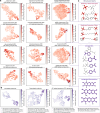ToxACoL: an endpoint-aware and task-focused compound representation learning paradigm for acute toxicity assessment
- PMID: 40593807
- PMCID: PMC12218982
- DOI: 10.1038/s41467-025-60989-7
ToxACoL: an endpoint-aware and task-focused compound representation learning paradigm for acute toxicity assessment
Abstract
Multi-species acute toxicity assessment forms the basis for chemical classification, labelling and risk management. Existing deep learning methods struggle with diverse experimental conditions, imbalanced data, and scarce target data, hindering their ability to reveal endpoint associations and accurately predict data-scarce endpoints. Here we propose a machine learning paradigm, Adjoint Correlation Learning, for multi-condition acute toxicity assessment (ToxACoL) to address these challenges. ToxACoL models endpoint associations via graph topology and achieves knowledge transfer via graph convolution. The adjoint correlation mechanism encodes compounds and endpoints synchronously, yielding endpoint-aware and task-focused representations. Comprehensive analyses demonstrate that ToxACoL yields 43%-87% improvements for data-scarce human endpoints, while reducing training data by 70% to 80%. Visualization of the learned top-level representation interprets structural alert mechanisms. Filled-in toxicity values highlight potential for extrapolating animal results to humans. Finally, we deploy ToxACoL as a free web platform for rapid prediction of multi-condition acute toxicities.
© 2025. The Author(s).
Conflict of interest statement
Competing interests: The authors declare no competing interests.
Figures







Similar articles
-
Predicting cognitive decline: Deep-learning reveals subtle brain changes in pre-MCI stage.J Prev Alzheimers Dis. 2025 May;12(5):100079. doi: 10.1016/j.tjpad.2025.100079. Epub 2025 Feb 6. J Prev Alzheimers Dis. 2025. PMID: 39920001 Free PMC article.
-
A deep learning approach to direct immunofluorescence pattern recognition in autoimmune bullous diseases.Br J Dermatol. 2024 Jul 16;191(2):261-266. doi: 10.1093/bjd/ljae142. Br J Dermatol. 2024. PMID: 38581445
-
Generalizable machine learning for stress monitoring from wearable devices: A systematic literature review.Int J Med Inform. 2023 May;173:105026. doi: 10.1016/j.ijmedinf.2023.105026. Epub 2023 Feb 28. Int J Med Inform. 2023. PMID: 36893657
-
Idiographic Lapse Prediction With State Space Modeling: Algorithm Development and Validation Study.JMIR Form Res. 2025 Jun 3;9:e73265. doi: 10.2196/73265. JMIR Form Res. 2025. PMID: 40460422 Free PMC article.
-
Multi-domain interventions for the prevention of dementia and cognitive decline.Cochrane Database Syst Rev. 2021 Nov 8;11(11):CD013572. doi: 10.1002/14651858.CD013572.pub2. Cochrane Database Syst Rev. 2021. PMID: 34748207 Free PMC article.
References
-
- Johnson, A. C., Jin, X., Nakada, N. & Sumpter, J. P. Learning from the past and considering the future of chemicals in the environment. Science367, 384–387 (2020). - PubMed
-
- Lane, M. K. M. et al. Green chemistry as just chemistry. Nat. Sustain.6, 502–512 (2023).
MeSH terms
LinkOut - more resources
Full Text Sources

